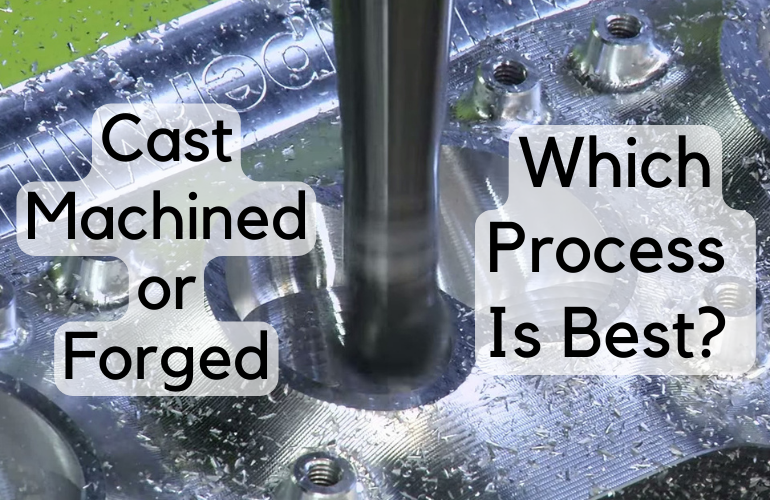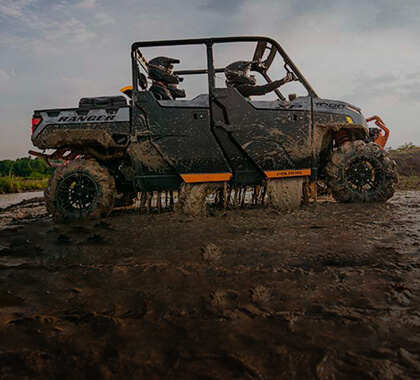How Exactly are Polaris Ranger Aluminum Parts Made?
May 2nd 2022
When searching for new parts and accessories for your Polaris Ranger, you’re going to find many different types of materials are used.
Manufacturers of aluminum parts and accessories tend to use three major processes when designing and producing a new product:
- Cast Aluminum
- Machined Billet Aluminum
- Forged Billet Aluminum
But what are the differences between cast, machined and forged aluminum? And how do you know which one is going to be the best option for your UTV?
Let's find out!
Cast Aluminum Polaris Ranger Parts

The casting process is fairly straightforward: aluminum is melted down (sometimes more than once) and is then poured into molds of the part that needs to be created. From beginning to end, this is one of the fastest ways to produce a finished product, and the parts can be created in rather large batches.
These facts are what make casting aluminum such a popular method: it is easy to produce and scale to any size order. Total cost is lower than just about any other method, which makes it both more profitable for the manufacturer, but also more affordable for the consumer.
Purchasing a cast aluminum Polaris Ranger Clutch, for instance, will be much more affordable than going for a higher-end material. And replacing the stock clutch with a Polaris Ranger 570 Clutch Kit By Duraclutch will still greatly improve your Ranger’s durability over the factory model.
One drawback, however, is the extra heating and melting of the aluminum during the process. This changes the crystalline structure of the metal, as well as introduces air pockets and even impurities to it. What this means, is that the final product may not always be as strong as some of the other options we will cover today.
Machined Billet Aluminum Polaris Ranger Parts

With the word billet referring to the form in which the aluminum blocks arrive at the manufacturer, you may still see the term ‘billet aluminum’ used when the term ‘machined billet aluminum is actually more accurate.
Once the billets of aluminum arrive at the manufacturer, the material is then milled and carved by CNC machines to create the final product. Billet aluminum is a higher grade than what is used for casting, and the machining process leaves much of the crystalline structure in tact. And doing so creates a stronger finished product than casting.
Another reason consumers love machined billet aluminum is actually its aesthetic! The machining process leaves behind a gorgeous finished product. Check out these billet aluminum Polaris Ranger Portal Gear Lifts to see what we mean! It is a night and day difference between how a billet part looks versus a cast part!
Machining these parts also means that a high level of precision can be achieved. With computers controlling the process, the design possibilities are virtually endless. If you can think it, and program it into the CNC, then you can make it!
So what could possibly be better than billet aluminum Polaris Ranger parts?
Forged Aluminum Polaris Ranger Parts

So, we’ve covered how casting aluminum requires the material to be melted down multiple times and poured into molds. We also touched on how billet aluminum can be machined, milled and carved into beautifully strong parts for your Ranger too.
But what about the forging process? Surely you’ve heard plenty of talk about forged aluminum, right?
With good reason, too, as it turns out.
The forging process starts out with the same grade billets of aluminum as the machining process. But instead of being milled and shaped by a CNC machine, the billet is forcefully formed into the shape of the parts needed. A large, and very powerful hydraulic press is used to simply smash and press the aluminum into shape using molds to guide the way.
Why do so many consider these parts a stronger final product?
Because the forging process changes the crystalline or grain structure of the metal least of the three processes we are comparing.
Besides a simple accessory such as the Polaris Ranger Forged Clevis Hook by Rough Country, forging parts such as a Polaris Ranger Grenade Beadlock Forged Wheels by KMC for instance, results in the strongest possible product built to withstand immense abuse on the trails.
The Verdict
All of this makes it sound like forged aluminum Polaris Ranger parts are the best, right?
Well, yes. And no.
There is still one major caveat to forging aluminum, in that the process itself restricts the amount and type of parts that can be created.
Compared to casting, which uses liquified aluminum poured into molds of any shape and size. Or the machined billets of aluminum that can be precision milled to any exact specification, forging aluminum may be a much more specialized process than the other two we have shared with you today.
When it comes down to decision time, we implore you to consider these points:
- Does the part exist in the material I prefer?
- Will the part look and fit how I want it to on my Polaris Ranger?
- How long can I expect the part to last given the production method?
- Does the part fit within my budget?
Ask yourself those four questions, and use them to narrow down your choices. Doing so will save you time, headaches, and quite possibly a lot of money in the end!


